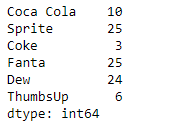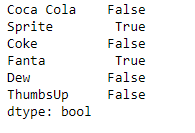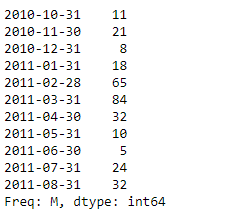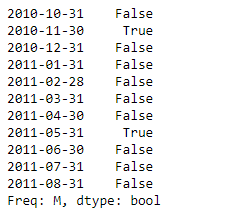Python Pandas Series.isin()
Pandas系列是一个带有轴标签的一维ndarray。标签不需要是唯一的,但必须是一个可散列的类型。该对象支持基于整数和标签的索引,并提供了大量的方法来执行涉及索引的操作。
Pandas Series.isin()函数检查数值是否包含在系列中。它返回一个布尔值系列,显示该系列中的每个元素是否与传递的数值序列中的一个元素完全匹配。
语法: Series.isin(values)
参数:
values :要测试的值的序列。
返回: isin : Series (bool dtype)
例子#1:使用Series.isin()函数来检查列表中传递的值是否包含在系列对象中。
# importing pandas as pd
import pandas as pd
# Creating the Series
sr = pd.Series([10, 25, 3, 25, 24, 6])
# Create the Index
index_ = ['Coca Cola', 'Sprite', 'Coke', 'Fanta', 'Dew', 'ThumbsUp']
# set the index
sr.index = index_
# Print the series
print(sr)
输出 :

现在我们将使用Series.isin()函数来检查传递的值是否包含在系列对象中。
# check if 25 is present
# in the series
result = sr.isin([25])
# Print the result
print(result)
输出 :

正如我们在输出中看到的,Series.isin()函数返回了一个包含布尔值的对象。如果在列表中存在,所有的值都被映射为真,否则为假。
示例#2 :使用Series.isin()函数来检查列表中传递的值是否包含在系列对象中。
# importing pandas as pd
import pandas as pd
# Creating the Series
sr = pd.Series([11, 21, 8, 18, 65, 84, 32, 10, 5, 24, 32])
# Create the Index
index_ = pd.date_range('2010-10-09', periods = 11, freq ='M')
# set the index
sr.index = index_
# Print the series
print(sr)
输出 :

现在我们将使用Series.isin()函数来检查传递的值是否包含在系列对象中。
# check if 21 and 10 is present
# in the series
result = sr.isin([21, 10])
# Print the result
print(result)
输出 :

正如我们在输出中看到的,Series.isin()函数返回了一个包含布尔值的对象。如果在列表中存在,所有的值都被映射为真,否则为假。
 极客教程
极客教程